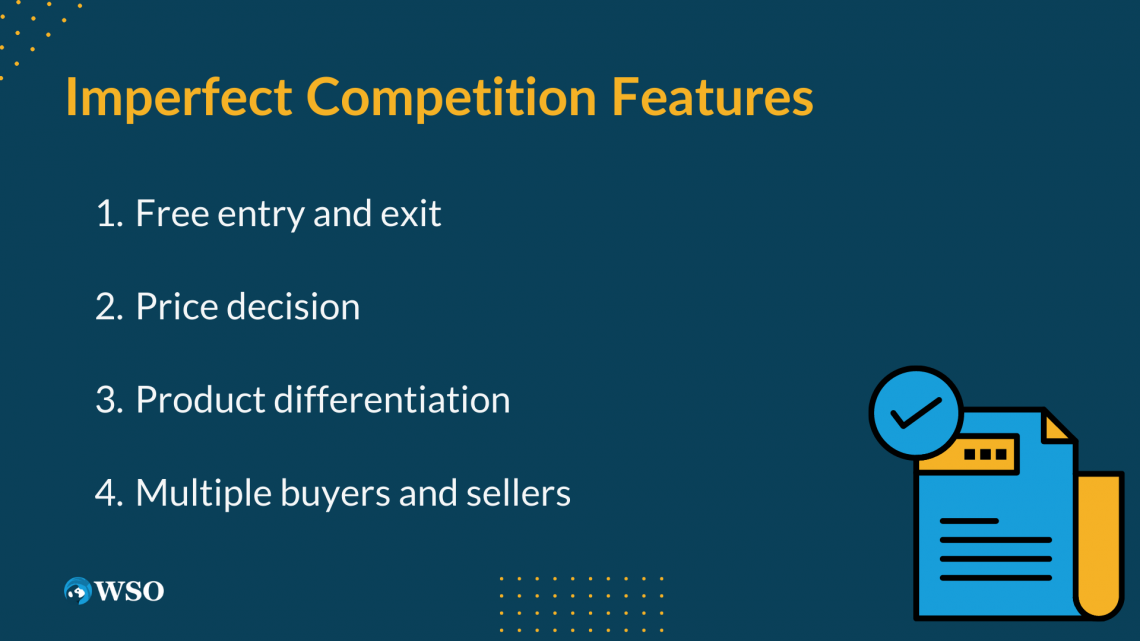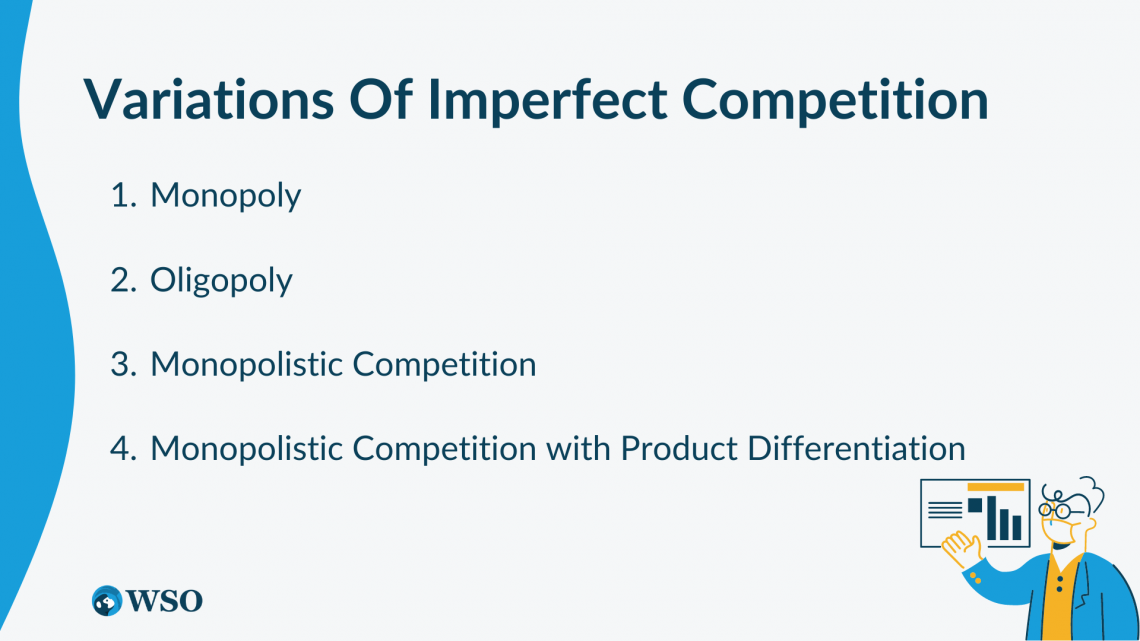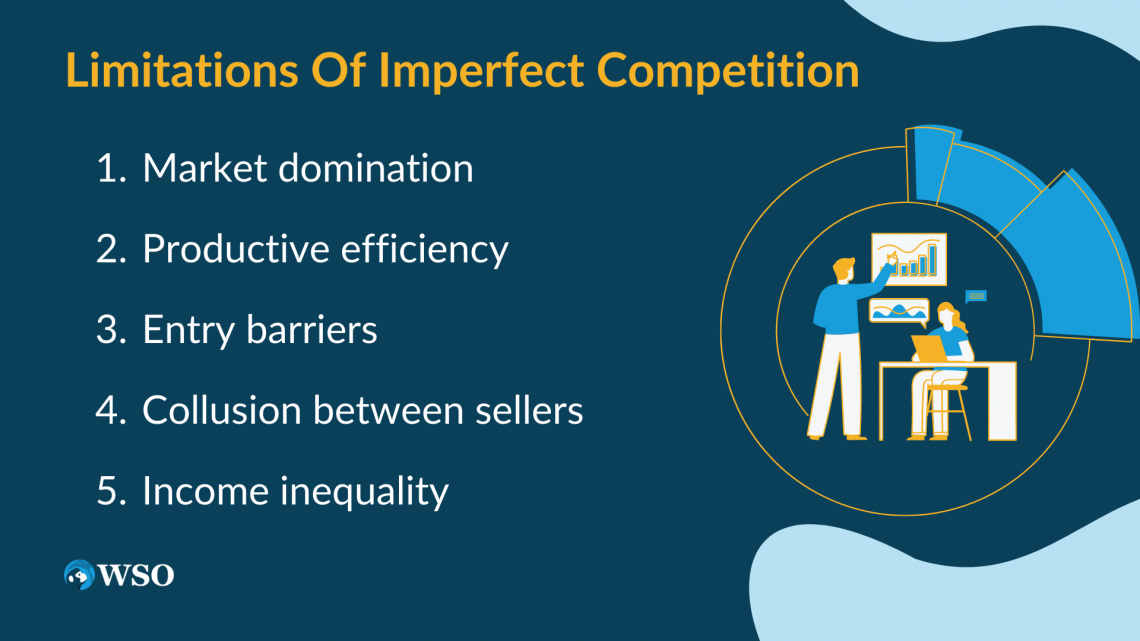Imperfect Competition
It refers to market structures where perfect competition conditions are not fully met, and firms have some degree of market power.
What is Imperfect Competition?
Imperfect competition in economics refers to a market structure where the conditions for perfect competition are not fully met.

It is characterized by a level of competition among sellers that is lower than what is observed in perfectly competitive markets. In imperfectly competitive markets, suppliers have some degree of market power, enabling them to influence prices and potentially generate surplus profits.
One of the key determinants of market shape and competition is the attention of suppliers inside the market.
The degree of market strength by firms influences their capacity to set fees above marginal price, mainly due to marketplace inefficiencies.
The more the volume to which charges are raised above the marginal prices, the greater the extent of marketplace inefficiency.

Imperfect competition encompasses various market structures, ranging from monopolistic competition, where many sellers offer differentiated products, to oligopoly, characterized by a few dominant firms, and monopoly, where a single firm has complete control over the market.
In imperfectly competitive markets, firms can influence prices, which can lead to higher profits.
This attracts new firms to enter the market, increasing competition and potentially reducing profits. Conversely, firms incurring losses may exit the market, further impacting competitive dynamics. Imperfect competition is also known as a competitive market.
Understanding imperfect competition is crucial for businesses to adapt their strategies and navigate competitive market conditions.
By analyzing competitors' market structure and behavior, companies can identify opportunities to differentiate their products, adjust pricing strategies, and target specific customer segments.

However, the competitive market also has limitations.
It can result in market failures, as the absence of perfect competition can lead to inefficient allocation of resources and reduced consumer welfare. In response, governments often intervene through regulation and antitrust measures to promote competition and protect consumer interests.
Recognizing the existence of imperfect competition allows businesses to adapt and strategize effectively, taking into account the competitive dynamics of the market in which they operate.
Key Takeaways
- Imperfect competition refers to market structures where perfect competition conditions are not fully met, and firms have some degree of market power.
- Different forms of imperfect markets include monopolistic competition, oligopoly, and monopoly, each characterized by varying levels of competition and market concentration.
- In imperfectly competitive markets, firms can influence prices and potentially earn higher profits, attracting new entrants and affecting competitive dynamics.
- Understanding the competitive market is essential for businesses to adapt their strategies, differentiate their products, and target specific customer segments.
- A competitive market can lead to market failures, inefficient resource allocation, and reduced consumer welfare.
- Governments often intervene through regulation and antitrust measures to promote competition and protect consumer interests in imperfectly competitive markets.
How Does An Imperfect Competition Work?
In an imperfectly competitive market, businesses are driven by the constant pursuit of a larger market share and the desire to develop superior products compared to their competitors.

The presence of market power allows firms to influence prices and capture a larger portion of the market.
This motivates businesses to engage in non-price competition, such as product innovation, branding, and marketing strategies, to differentiate themselves and attract customers.
In an imperfectly competitive market, competition revolves around gaining a larger market share and developing superior products compared to other businesses.
Several key features help explain how an imperfectly competitive market functions:

1. Free entry and exit
Businesses have the freedom to enter and exit an imperfectly competitive market. However, getting into one of these markets can be challenging, especially if the goods or offerings an enterprise plans to provide are similar to those offered by existing vendors.
2. Price decision
Sellers in an imperfectly competitive market have the autonomy to set prices for their products regardless of their competitors' pricing strategies.
They can determine the marketplace rate of their goods or services, thinking about elements together with production costs, purchaser demand, and competitors' pricing.
3. Product differentiation
In an imperfectly competitive market, even though goods and services may have comparable alternatives and target the same customers, they are differentiated.
Example
If Seller A offers baby food and Seller B sells feeding bottles, their products are distinct and not direct competitors
4. Multiple buyers and sellers
An imperfectly competitive market allows multiple sellers to operate independently without significantly impacting each other's performance.
Although numerous sellers may serve a specific market segment, the target market remains divided. This allows for multiple buyers with different preferences, needs, and willingness to pay.
Market segmentation allows businesses to focus on specific customer groups and tailor their offerings accordingly.
In an imperfectly competitive market, businesses must continuously adapt and innovate to gain a competitive edge. They must differentiate their products or services, effectively manage pricing strategies, build customer loyalty, and invest in marketing and branding initiatives.
Note
In imperfectly competitive markets, firms have some degree of market power, meaning they can influence prices and output levels. Unlike perfect competition, where no single firm controls the market, imperfect competition allows firms to differentiate their products, engage in strategic pricing, and potentially restrict competition.
5. Non-price competition
In addition to setting prices, businesses in an imperfectly competitive market engage in non-price competition.
This involves numerous advertising and marketing strategies, including advertising, product promotion, branding, and customer service, to differentiate themselves from competitors.
The non-price competition aims to create perceived value and build customer loyalty, focusing on aspects beyond just the product's price.
Variations Of Imperfect Competition
Imperfect market competition refers to a market structure in which there are a limited number of firms operating and exerting some degree of influence over the market price.

Unlike perfect competition, where numerous small firms operate independently and have no control over prices, a competitive market allows for market power and strategic behavior by firms.
In an imperfectly competitive market, firms can differentiate their products, create barriers to entry, and influence prices. This can result in higher prices and reduced consumer welfare compared to perfect competition.
Imperfect market competition can take different forms, including:
- Monopolistic Competition
- Oligopoly
- Monopoly
- Monopolistic Competition with Product Differentiation
Let us delve into a deeper understanding of the types:
1. Monopoly
A monopoly occurs when a single firm dominates the complete marketplace and has jurisdiction over the supply of a particular service or product.
It faces no direct competition and has the ability to set prices at its discretion.
Note
Entry barriers, such as patents, high initial investment costs, or government regulations, often lead to a monopoly's establishment. An example of a Monopoly is Google in the internet industry.
2. Oligopoly
Oligopoly refers to a market structure dominated by a small number of large firms. These firms have significant market power and can influence prices through strategic decision-making, such as collusion or price leadership.
Interactions among oligopolistic firms are characterized by intense competition, strategic interdependence, and non-price competition. OPEC is a great example of an Oligopoly
3. Monopolistic Competition
Monopolistic competition exists when numerous firms operate in a market, each offering slightly differentiated products or services.
Firms have limited control over market prices due to product differentiation, which creates a degree of brand loyalty among consumers.
Note
Entry and exit barriers are relatively low, leading to a relatively large number of firms in the market. Fast food chains like McDonald’s are one example.
4. Monopolistic Competition with Product Differentiation
This type of imperfect competition is similar to monopolistic competition but strongly emphasizes product differentiation.
Firms engage in extensive marketing, advertising, and branding efforts to establish a unique product identity. Product differentiation allows firms to exert some control over prices, but competition still exists among differentiated products within the market.
A competitive market encompasses various market structures, including monopoly, oligopoly, monopolistic competition, and monopolistic competition with product differentiation.
Each type has distinct characteristics that impact the behavior of firms and the degree to which they compete.
Note
Imperfect competition often leads to monopolies or oligopolies in certain industries. Monopolies occur when a single firm dominates the market and has exclusive control over a particular product or service supply. Conversely, oligopolies involve a small number of large firms that collectively dominate the market.
Limitations Of Imperfect Competition
The concept of imperfect competition, which refers to market structures that fall between perfect competition and monopoly, comes with several limitations that impact the efficiency and fairness of markets.

1. Market domination
One significant limitation is the potential for market power and abuse of dominant positions by firms. In imperfectly competitive markets, certain firms may be able to influence prices and restrict output, leading to reduced consumer welfare.
This can result in higher prices, limited choices, and decreased allocation efficiency.
2. Productive efficiency
The imperfect competition also poses challenges in achieving productive efficiency. In markets where firms have some degree of market power, they may lack the incentive to minimize costs and maximize production efficiency.
Note
Without intense competition, firms may become complacent and fail to innovate or invest in technological advancements that could enhance productivity.
3. Entry barriers
Imperfect competition can lead to the existence of barriers to entry, creating entry barriers that limit competition and hinder market dynamics.
These limitations, including excessive capital requirements or distinct agreements, prevent new corporations from entering the market and project the belief of a stage-playing subject.
Note
The lack of access and competition may ultimately result in reduced consumer desire, much less innovation, and higher costs.
4. Collusion between sellers
Another limitation of imperfect competition is the potential for collusion and anti-competitive behavior among firms.
In markets with a small number of dominant players, there is a risk of collusion, where firms coordinate their actions to manipulate prices or restrict competition. Such behavior can harm consumers and undermine the functioning of the market.
5. Income inequality
Lastly, imperfect competition can lead to income and wealth disparities. In markets where firms have market power, they can capture a significant share of the market's economic profits. This concentration of wealth can exacerbate income inequality and hinder social mobility.
Note
While imperfect competition allows for more realistic market models that better reflect real-world conditions, it comes with limitations that necessitate careful regulation and competition policy to ensure fair and efficient market outcomes.
Perfect Vs. Imperfect Competition
While perfect competition represents an idealized market structure governed solely by market forces, imperfect competition characterizes real-world markets that deviate from this theoretical model.

Perfect competition, though purely theoretical, serves as a benchmark against which actual market effectiveness and efficiency are assessed.
In a perfect market, resources would be equitably distributed among companies, eliminating the existence of monopolies.
Each company would possess identical industry knowledge and offer identical products. Moreover, the market would teem with numerous buyers and sellers, allowing demand to harmoniously determine prices.
To achieve perfect competition, several conditions must be met, including the presence of identical products, price determination through supply and demand, equal market share among companies, widespread access to price and product information, and low or no barriers to market entry and exit.
Note
Notably, the government cannot regulate entry and exit in perfect competition. In contrast, imperfect competition pervades real-world industries, where one or more conditions of perfect competition remain unmet.
Additionally, an essential concept in understanding market dynamics is the demand curve. The demand curve illustrates the relationship between the price of a product and the quantity demanded by consumers.
In perfect competition, the demand curve for an individual firm's product is perfectly elastic, indicating that the firm can sell any quantity of the product at the prevailing market price.
Conversely, imperfect competition introduces variations in the shape and elasticity of the demand curve, reflecting the influence of factors like brand loyalty, product differentiation, and market power.
| Criteria | Perfect Competition | Imperfect Competition |
|---|---|---|
| Number of Buyers/Sellers | Large number | Few or limited |
| Product Differentiation | Identical products | Differentiated products |
| Information | Perfect information | Imperfect information |
| Price Determination | Price takers (no control over price) | Some control over the price |
| Entry/Exit Barriers | Free entry and exit | Barriers to entry or exit |




or Want to Sign up with your social account?